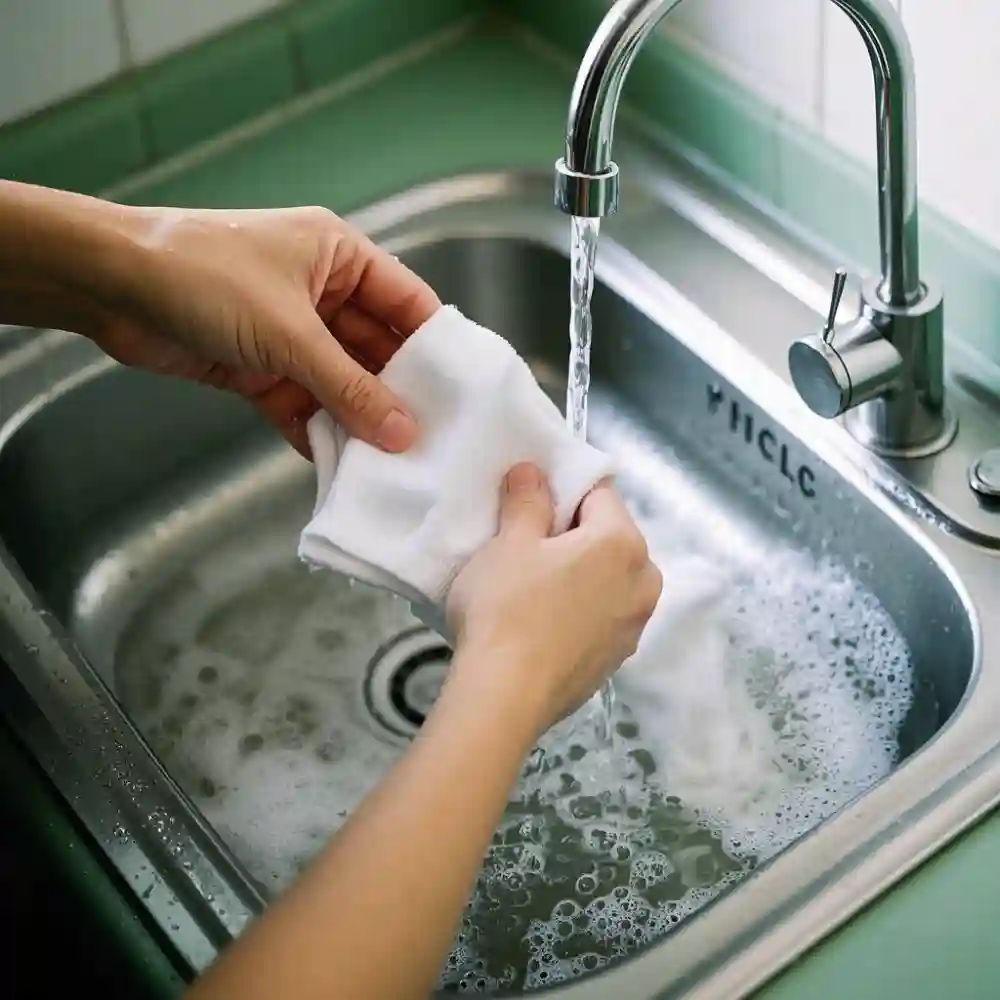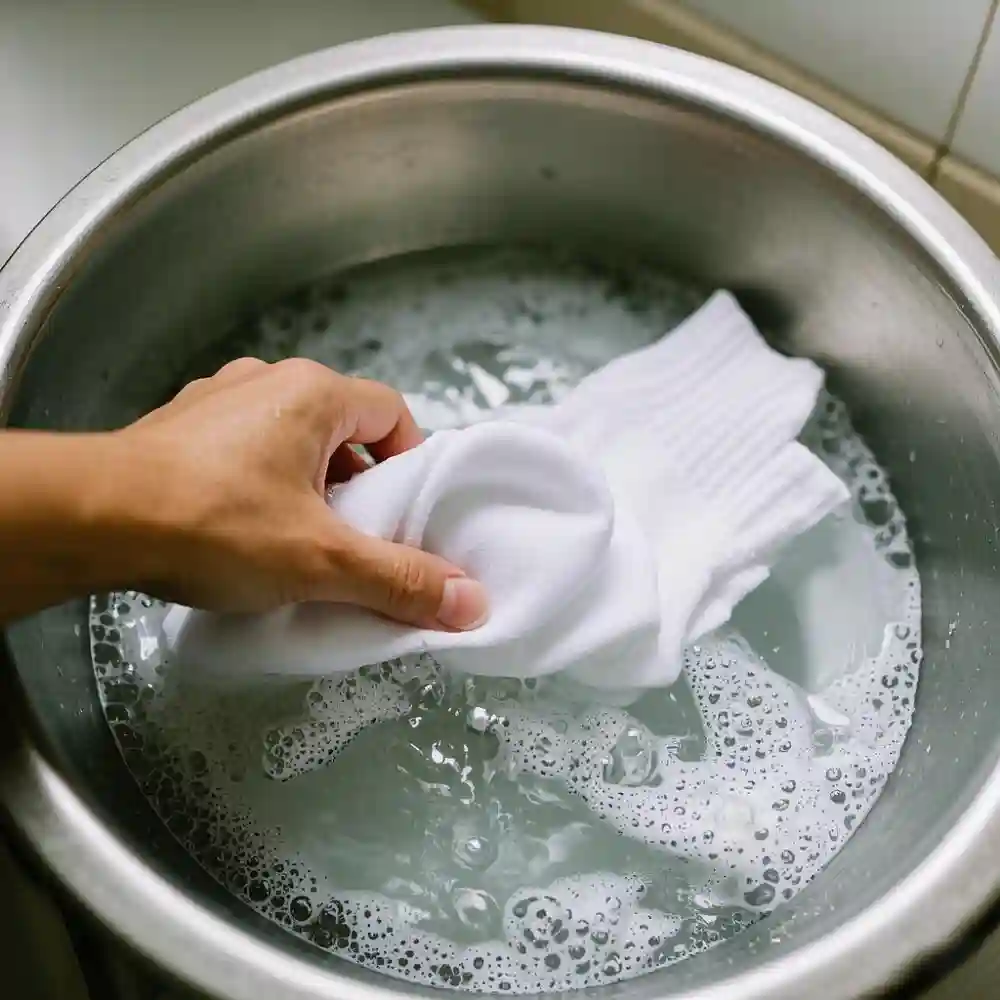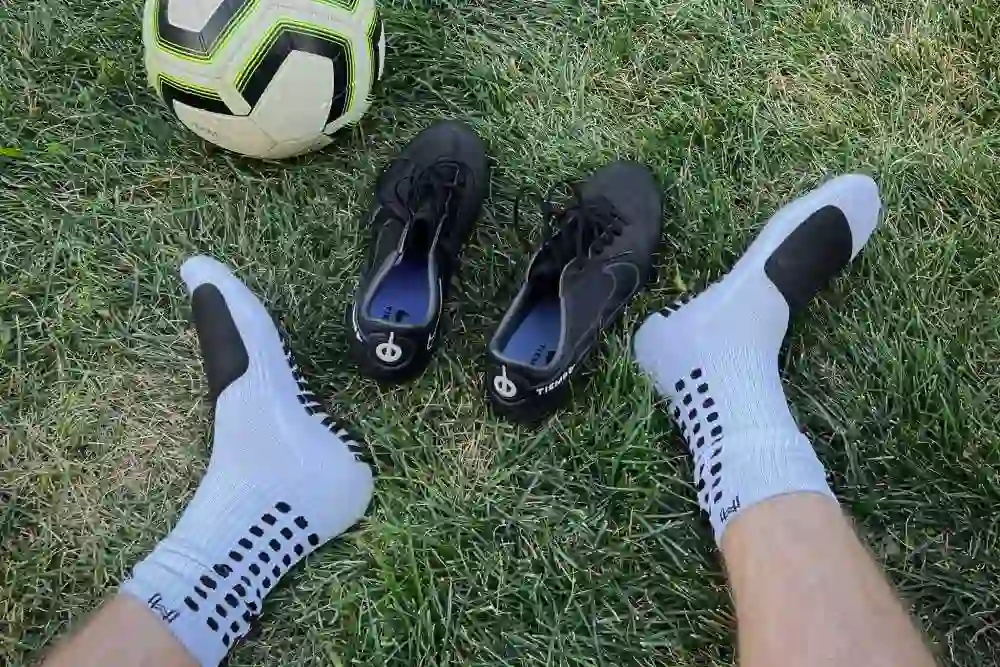Introduction
Grip socks have become a must-have for anyone engaging in activities like yoga, gym workouts, or even navigating slippery floors at home. Designed to offer stability, support, and traction, they help prevent slips and improve comfort. However, just like any specialized gear, grip socks require proper care to maintain their performance. Improper washing can lead to worn-out grip pads or fabric that loses its elasticity, diminishing their effectiveness. Follow these tips to ensure your grip socks stay as reliable and comfortable as the first time you put them on.

To maximize durability, turn grip socks inside-out and wash them in cold water on a gentle cycle with mild detergent. Crucially, avoid bleach and fabric softeners, as these can degrade the silicone grips. For best results, air-dry them or tumble dry on the lowest heat setting. Browse our full range of custom grip socks for your brand.
Understanding Grip Socks: Materials and Construction
Grip socks are crafted with specific materials to provide both comfort and functionality. They typically contain cotton, spandex, and sometimes polyester or nylon. Cotton offers breathability and softness, while spandex ensures a snug, comfortable fit. Nylon and polyester enhance durability and wick moisture away from your feet during high-intensity activities. Higher-end options may include antimicrobial fibers like bamboo or copper for added benefits, such as odor control.
The defining feature of grip socks is the silicone or rubber grip pattern on the soles. These textured pads help prevent slipping by improving traction, especially when placed strategically at the heel, arch, and balls of the feet. To keep these performance-enhancing features intact, it’s important to properly care for the socks and avoid wear and tear from poor washing habits.
The Importance of Proper Care
The longevity of grip socks depends on maintaining both the fabric and grip pattern. Excessive heat or harsh detergents can break down the fabric, causing it to lose its shape, while high temperatures can weaken or even melt the grip. For the best results, follow the correct washing instructions to preserve both the comfort of the fabric and the traction of the grip pads.
Step-by-Step Guide: How to Wash Grip Socks
Proper washing is key to keeping your grip socks in top condition. Follow these simple steps to preserve their performance over time.
Prepare Your Grip Socks for the Wash
Start by turning your grip socks inside out. This helps protect the grip pattern from wear caused by friction with other items in the wash. If there are any stains, gently spot clean them with a mild detergent. Avoid washing your socks with rough items like towels or anything with zippers or velcro, which can damage the fabric. And if the color of your grip socks is light, please don’t put them in the wash with dark color socks or clothes.
Hand Wash vs. Machine Wash
Hand washing is gentler on both the fabric and grip, so it’s the preferred method. Use lukewarm water and a mild detergent, gently rubbing the socks to remove dirt. Rinse thoroughly to ensure no detergent residue is left behind. If you opt for machine washing, place your socks in a mesh laundry bag to minimize friction. For studios and brands that need socks to survive frequent washing cycles, check out our bulk non-slip yoga & Pilates grip socks designed for wash-resistant performance. Use a gentle cycle with cold or lukewarm water and avoid harsh detergents or fabric softeners, as they can damage the material.
Water Temperature Matters
Washing in hot water can shrink the fabric, cause fading, and weaken the grip. Stick to cold or lukewarm water to maintain the integrity of both the fabric and grip pattern. Cold water is especially effective at preserving elasticity and comfort, while lukewarm water is better for stubborn stains without risking damage.
Best Detergents for Grip Socks: What to Use and Avoid
Choosing the right detergent plays a crucial role in maintaining the quality of your grip socks. Some detergents can damage the fabric and reduce the grip’s effectiveness, while others help preserve the sock’s performance. Here’s what to look for:
Gentle, Eco-Friendly Detergents vs. Harsh Chemicals
Avoid detergents containing harsh chemicals like artificial fragrances, brighteners, and bleach. These can degrade the fabric, wear down the grip, and cause faster deterioration of your socks. Eco-friendly detergents made from plant-based ingredients are a better choice. These are typically free from harmful additives like phosphates and parabens and are gentler on both the fabric and the grip material.
How Harsh Detergents Can Damage the Grip
Grip socks feature silicone or rubber pads to provide traction, but these materials are sensitive to strong chemicals. Harsh detergents can cause the silicone to lose flexibility, reducing its effectiveness. Over time, this can lead to peeling, cracking, or breakdown of the grip pads. Harsh chemicals can also affect the fabric, causing fading, shrinking, and loss of elasticity.

The Best Detergents for Preserving Grip Sock Materials
Look for mild, liquid detergents specifically designed for activewear or delicate fabrics. These products are formulated to clean effectively without compromising the integrity of the fabric or grip material. Natural, plant-based detergents—such as those made with coconut or other gentle cleansers—are ideal for performance socks. They are tough on stains but won’t break down the fibers or grip pads. Specialized detergents for sports gear are also excellent choices, as they help maintain the breathability, stretch, and grip of the socks.
Avoiding Common Washing Mistakes
Certain washing habits can lead to premature wear and damage to your grip socks. Avoiding these common mistakes will help extend the lifespan of your socks.
Washing With Zippers, Velcro, or Other Items
Avoid washing your grip socks with items that have zippers, Velcro, or rough textures, such as towels. Zippers can catch on the fabric, and Velcro can cling to the grip, causing it to peel. Rough items can create friction that wears down the fabric, weakening both the sock material and grip pattern. Always wash grip socks with similar fabrics or place them in a mesh laundry bag for added protection.
Overloading the Washer: Why It’s a Bad Idea
Overloading the washer can cause friction, which may stretch or tear the fabric, and reduce the effectiveness of the grip pads. Explore football grip socks engineered to stay grippy after repeated washing. The socks won’t have enough room to move freely, and they may not get cleaned properly. Wash grip socks on their own or with just a few other soft items to ensure they have enough space to be cleaned without unnecessary wear.
Forgetting to Turn Socks Inside Out
Turning your socks inside out before washing is crucial. This simple step protects the grip pads from excessive friction, which can cause them to lose their effectiveness. It also helps to clean the inside of the socks more thoroughly, where sweat and oils accumulate. Neglecting this step can lead to faster deterioration of the grip and overall comfort.
Drying Grip Socks: The Dos and Don’ts
Proper drying is as important as washing when it comes to maintaining the quality and longevity of your grip socks. How you dry them affects both the fabric and grip, so it’s crucial to follow the right techniques. Here’s what you need to know to keep your socks in top shape.
Air Drying vs. Machine Drying
Air drying is the safest method for grip socks. It preserves the fabric’s elasticity and prevents damage to the grip pads. Lay the socks flat on a clean surface or hang them by the toe to maintain their shape. Avoid hanging by the cuff, as this can stretch the fabric over time. While air drying takes longer, especially in humid conditions, it ensures the socks maintain their performance and durability.
Machine drying is faster but poses risks. High heat and tumbling can shrink the fabric, weaken elasticity, and damage the silicone or rubber grips. If machine drying is necessary, always use the lowest heat setting and a delicate cycle to minimize damage.
The Dangers of High Heat on Grip Socks
High heat is a primary cause of damage to grip socks. It can shrink or warp the fabric, making the socks less comfortable and reducing their lifespan. Silicone or rubber grips are especially sensitive to heat, which can cause them to crack, become brittle, or lose their traction entirely. To preserve both fabric and grip, always avoid high-heat drying cycles and prolonged exposure to direct sunlight.
How to Properly Air Dry Your Grip Socks
- Reshape the Socks: After washing, gently reshape the socks to their original form. This prevents stretching or distortion during drying.
- Flat or Toe Hanging: Lay socks flat on a drying rack or hang them by the toe. Avoid hanging by the cuff to prevent stretching.
- Ventilated Area: Dry socks in a well-ventilated area to ensure even drying. Use a fan if necessary, especially in humid environments. Avoid prolonged sun exposure, which can fade fabric and weaken grips.
Storing Grip Socks: Best Practices for Longevity
Proper storage helps maintain the quality of your socks by protecting both the fabric and grip. Follow these tips to ensure your socks remain fresh and functional.
- Fold, Don’t Roll
Avoid rolling or tightly folding socks, as this can compress and deform the grip pads. Instead, fold them flat with the grip side up, ensuring the silicone or rubber pattern isn’t bent or pressed. - Organized Storage
Use drawer dividers or storage bins to neatly arrange your socks. Keep them separated from heavier items to avoid unnecessary pressure or friction that could wear down the fabric or grip. - Avoid Overcrowding
Overcrowded storage spaces can stretch fabric and degrade the grip pads. Ensure your socks are stored with enough space to avoid compression and friction.
Dealing with Odors: How to Keep Grip Socks Fresh
Grip socks can easily accumulate odors due to sweat and moisture from physical activities. Keeping them fresh not only enhances their comfort but also prevents bacteria build-up. Follow these tips to eliminate and prevent odors effectively.
Wash Promptly After Use
Odors primarily result from sweat and bacteria left on the socks after use. Wash your socks promptly to remove bacteria and moisture before odors have a chance to set in. Allowing damp socks to sit can lead to a buildup of unpleasant smells.
Dry Thoroughly After Each Wear
Ensure socks are completely dry before storing them. Damp conditions create an ideal environment for bacteria, leading to persistent odors. Air-drying in a well-ventilated area after each use prevents this issue.
Use Natural Remedies for Odor Removal
For stubborn odors, natural solutions like baking soda and vinegar are excellent options:
- Baking Soda: Sprinkle a small amount inside the socks before washing to neutralize odors.
- White Vinegar: Add a cup to the wash cycle for antibacterial properties that eliminate bacteria and smells without harsh chemicals.

When to Replace Grip Socks
Grip socks are durable but not indestructible. Recognizing signs of wear and replacing them when necessary ensures safety and comfort.
- Loss of Grip: If the silicone or rubber traction has worn off or become uneven, the socks can no longer provide the necessary stability, increasing the risk of slipping.
- Fabric Degradation: If your socks no longer fit snugly, or if the fabric feels loose or stretched out, they may not offer the support and comfort they once did.
- Visible Damage: Holes, tears, or thinning in high-stress areas (like the toe, heel, or arch) indicate the socks are no longer effective.
Other Tips to Prolong the Lifespan of Grip Socks
- Trim your toenails regularly to prevent the fabric from snagging or breaking.
- Rotate between multiple pairs of socks to reduce wear and tear on each pair, allowing them to last longer.
- Avoid walking outdoors with your socks, as this can damage the grip and introduce unnecessary dirt.
Recycling Worn-Out Grip Socks
Instead of discarding old socks, consider repurposing them to reduce waste:
- Cleaning Cloths: Old socks make excellent cleaning rags. Their soft, absorbent fabric is perfect for dusting or wiping down surfaces, and the material can handle spills or grime without leaving streaks.
- Craft Projects: Get creative with your worn-out socks by turning them into DIY projects. Use them to make soft toys, or repurpose them into cozy hand warmers or even sock puppets.
- Gardening Uses: Old socks can be used in the garden as plant ties or supports. The soft material won’t harm the plants, and they’re great for holding vines or small plants in place.
- Composting: If your socks are made from natural fibers like cotton, they can be composted once they’re beyond repair. Just make sure to remove any synthetic grip material or rubber before composting.
Conclusion
Proper care and maintenance are essential to keeping your grip socks durable, comfortable, and effective. By washing, drying, and storing them correctly, you can extend their lifespan and ensure they continue to perform at their best. Regular odor management and timely replacements are key to maintaining their functionality.
Interested in learning more about grip socks or need custom solutions for your brand? Contact us today! We specialize in high-quality, durable grip socks tailored to your business needs. Let us help you create the perfect socks that combine comfort, performance, and style for your brand.
FAQs
1. What is the best way to wash my grip socks to protect the grips?
For best results, machine wash your socks inside-out on a gentle cycle with cold water and a mild detergent. Using a mesh laundry bag offers extra protection for the silicone grips. While hand washing is gentlest, a careful machine wash is convenient and cleans thoroughly without causing damage.
2. Can I put my grip socks in the dryer? No, never tumble dry your grip socks. The high heat from a dryer can damage and degrade the silicone grips, causing them to peel, crack, or lose their stickiness. To preserve their function and fit, always lay them flat or hang them up to air dry completely.
3. Are there any cleaning products or methods I should avoid? Absolutely. To protect the grips and fabric, never use bleach or fabric softeners, as these can break down the materials. You should also never iron the socks, especially the silicone soles. Stick to a gentle, bleach-free detergent for the best and safest results for long-term use.
4. How can I make my grip socks last longer? Simple habits make a big difference. Always turn your socks inside-out before washing to protect the grips from abrasion. After washing, gently reshape them and always let them air dry. Consistently following these care steps is the most effective way to maximize their lifespan and maintain their performance.
5. Is there a special step for the very first wash? Yes, we recommend washing your grip socks before their first use. For that initial wash, it’s best to launder them separately from other garments to prevent any potential color bleeding. This ensures they are perfectly clean, fresh, and ready for optimal performance from the very first wear.or. Over time, even with daily wear, proper care will extend their lifespan and maintain their performance.
